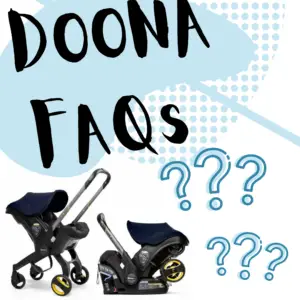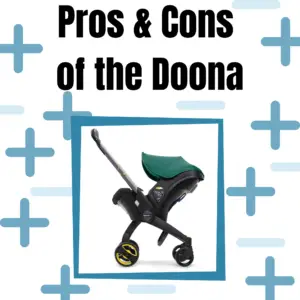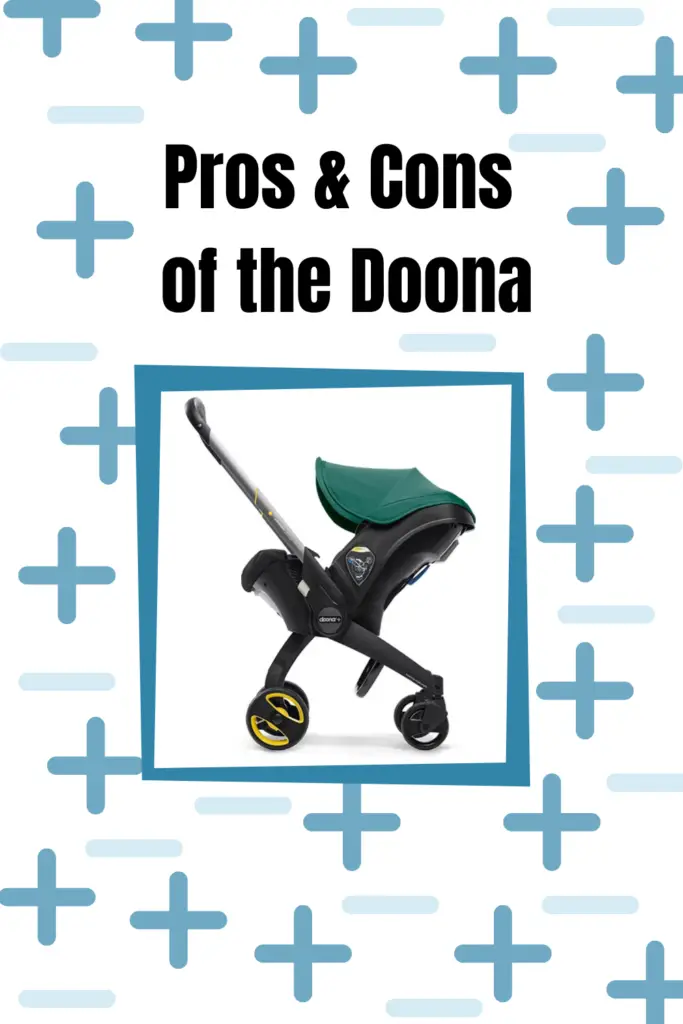
We put together a list of list of the major pros and cons of the Doona car seat/stroller travel system.

Note: This post may contain affiliate links. This website is largely reader-funded through making purchases using affiliate links (at no additional cost to you). Thank you for your support!
Each family should look at the pros and cons of the Doona to decide if it’s worth it for them. We put together a list of the pros and cons of the Doona to help you make your decision!
Here’s a list of the major pros or benefits of the Doona stroller:
If you want a car seat that turns into a stroller, the Doona is the only car seat that does this. It’s truly a unique product!
It is extremely easy to unfold the Doona and convert the car seat to a stroller (and vice versa). It literally takes only seconds and you do not have to remove the baby!
You simply place the carrier on the ground, adjust the handle, unlock the wheels then lift upwards until the wheels lock into place. To convert from stroller to back to carrier/car seat is just as simple.
Like most infant car seats, the Doona comes with a car seat base, which makes using the car seat a breeze. With the use of the base, it takes only seconds to put the Doona in and take it out.
If you have multiple cars, you can buy an extra base for your Doona to make switching the Doona between cars seamless.
With traditional travel systems, parents have to juggle putting the car seat and stroller away. If you’re by yourself, you essentially have two options: 1) Put the car seat in the car then put the stroller in the trunk or 2) Put the stroller away first (with the car seat at your feet), then put the baby and the car seat in the car. The Doona solves the problem of the juggling act.
The Doona stroller weighs in at 16.5 pounds. This would be considered a lightweight stroller.
For comparison purposes, the stylish UPPAbaby Vista V2 weighs 26.6 pounds, the popular Mockingbird stroller weighs 26.5 pounds, and the UPPAbaby Minu weighs an impressive 15 pounds.
The Doona travel system doesn’t take up a lot of space. It’s perfect for maneuvering through tight spaces like stores and restaurants. It’s also perfect if you have limited storage space.
The Doona is compact, making it perfect for city dwellers who have limited storage space for bulky car seat and stroller systems. Not only that, it can also be used very easily in Ubers and taxis without the car seat base. If you plan on traveling in rideshares or taxis, you should know that not all infant car seats can be installed without the base (like the Nuna Pipa Lite).
The Doona is great for airline travel. It is FAA approved and can be installed on most airplanes without the base with the airplane’s lap belt. The Doona can also be pushed down the center aisle of most airplanes as a stroller. Experts (including the AAP and car seat technicians) recommend that children sit in car seats when traveling by plane and the Doona makes this task easier and less daunting. (P.S. it can also be gate checked if you don’t want to fly with it, but still want to use it in the airport and at your destination).
Many parents love the convenience of using their Doona stroller when navigating through the airport. Though probably the biggest convenience is not having to travel with a separate stroller and car seat – it’s an all-in-one system!
The Doona can be used for babies weighing as little as 4 pounds. Nearly half of the infant car seats on the market start at 5 pounds.
The Doona seat cover, shoulder pads and canopy can be removed for washing. Many parents report that removing and recovering fabric for the Doona is easy. With infants, car seat messes are inevitable and having easy to remove car seat covers makes cleaning much easier.
The Doona comes in many different stylish color options.
The Doona definitely is a showstopper and conversation starter. It stands out from any other stroller. If you get the Doona stroller, you’ll likely get many looks and people coming up to you with questions.
There are tons of positives or “pros” to the Donna stroller, but there are also several negatives or “cons” you need to consider.
Though light for a stroller, the Doona is heavy for an infant car seat. The Doona, weighing in at 16.5 pounds is much heavier the the vast majority of car seats, which range from 8-11 pounds. The lightest car seat on the market weighs only 5.3 pounds!
Like with most infant car seats, the lifespan is about a year. Depending on the growth of your child, you could get less or more time out of the Doona. Children can use the Doona until they exceed one of three limits: 1) 32 inches in height, 2) 35 pounds or 3) less than 1 inch of space between the top of the child’s head and the top of the car seat.
Once your child outgrows the Doona, it can not be used as a stroller anymore either. The (approximate) one year lifespan of the Doona stroller is short compared to the useful life of any other stroller on the market.
Many experts have come out with concerns over infants spending extended periods of time strapped in infant car seats. There is an unofficial rule that infants should only be in their car seat 2 hours at a time.
Many experts (including the AAP) have stated infants should not be sleeping in their car seats outside of a moving vehicle.
For this reason, we don’t recommend the Doona for long walks or trips in the stroller.
With most strollers, you can adjust the seat back and recline the seat. However, this is not the case with the Doona given it’s also an infant car seat.
Aside from the safety concerns with children spending too much time in their car seat, most children don’t like being strapped into their car seat.
Some babies don’t tolerate the car seat, making even short trips miserable. In this case, the Doona (or any travel system for that matter) is not the best purchase. For babies who are intolerant of their car seat, transferring them to a traditional stroller is likely a better option. For babies who can’t yet sit on their own, you will need a stroller that lies completely flat (or has a bassinet).
Even babies who tolerate the car seat well still may prefer to sit in traditional strollers. This is especially true as they begin sitting up un-assisted (usually around 6-9 months). Most babies would prefer being able to sit up and take in their surroundings as opposed to being strapped in an infant car seat. Around this age, many parents also choose to forward-face their stroller if it was once parent-facing based on the cues of their child. The Doona doesn’t have the option of forward-facing (only parent-facing). Allowing children to sit in a traditional stroller allows freedom of movement that being strapped in a car seat just doesn’t allow.
There is no storage under the Doona that is typically found in most strollers. This is due to the unique feature where the wheels fold under the seat to convert to a car seat. However, Doona does sell a storage basket accessory, but this adds an additional step every time you use the Doona.
The handlebar of the Doona has several heights that you can adjust to, but even at the tallest height, it’s on the shorter side. The maximum handlebar height of the Doona is 38 inches from the ground. Though it’s not impossible to push if you’re tall, it’s definitely not the most ideal handlebar height.
The Doona stroller has smaller wheels compared to standard sized strollers. Though comparable with the wheels of many travel strollers, this makes strolling over rougher terrain more bumpy. The Doona is better suited for smoother surfaces. We don’t recommend the Doona for off-roading or rough terrain.
The sunshade of the Doona is on the smaller side compared to some other infant car seats and strollers. It’s not expandable but you can buy a canopy extension separately.
The Doona costs $549. And it rarely goes on sale. Even though you are getting both a car seat and a stroller, this is still a lot of money. For the same price as the Doona (or less), you could get a separate car seat and stroller (that work together as a travel system). You might find that it’s better to invest your money in a good stroller which will last many more years than the Doona travel system.
If you’re Canadian, sorry, but the Doona is illegal in Canada. Canada has different car seat testing requirements and the Doona does not bear the required Canadian “National Safety Mark”. You can’t import or use the Doona car seat if you’re Canadian. We talk more about this topic in our Doona FAQ article.
We think the Doona is a great product overall. It is very cleverly designed and engineered. Parents will definitely enjoy using it while in the relatively narrow period of time their child can fit in it. We kind of think of it like the exotic sports car of the stroller/car seat world. It’s nicely designed and great to use but impractical long term and expensive to purchase. In the end, each family should take into account the pros and cons of the Doona travel system to determine if it’s a good match for you and your family’s lifestyle. You can purchase the Doona here.

